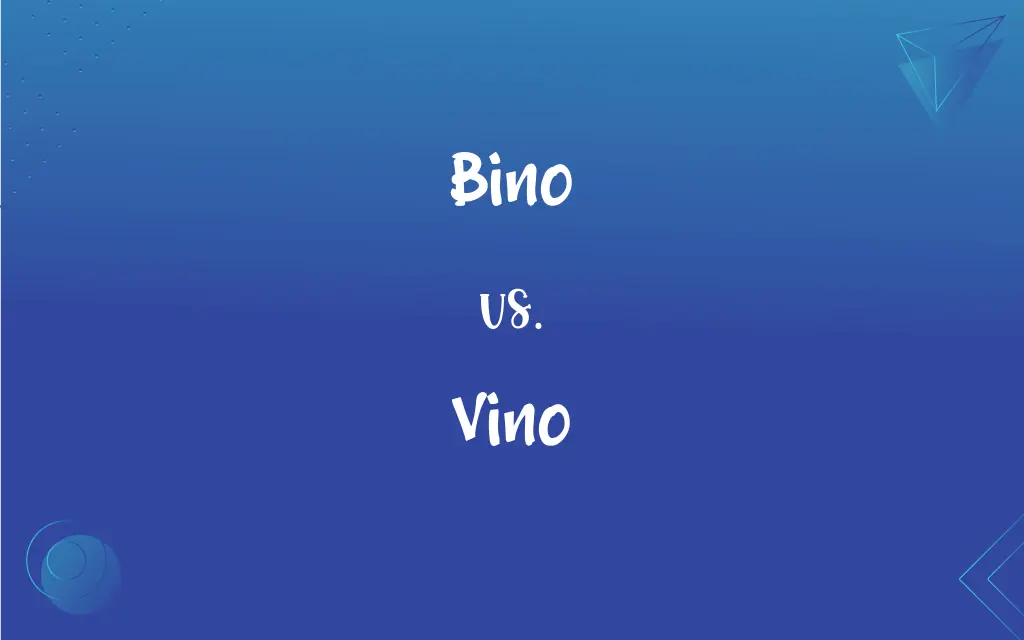Bino vs. Vino: What's the Difference?
By Janet White & Aimie Carlson || Updated on May 21, 2024
Bino refers to binoculars, an optical device for viewing distant objects, while Vino is the Italian and Spanish word for wine, an alcoholic beverage made from fermented grapes.

Key Differences
Bino, short for binoculars, is an optical instrument used to view distant objects by both eyes simultaneously. They are commonly used in activities like bird watching, sports events, and stargazing, providing a magnified view and depth perception. On the other hand, Vino is the Italian and Spanish term for wine, a popular alcoholic beverage made from fermented grapes. Wine is enjoyed in many cultures worldwide and is a staple in various social and culinary contexts.
Bino enhances vision and enables users to see faraway objects with greater clarity, making it a valuable tool for outdoor enthusiasts and professionals. Whereas Vino is appreciated for its flavors, aromas, and the social experiences it brings, often associated with dining, celebrations, and relaxation. Wine comes in various types, including red, white, and rosé, each with distinct characteristics.
Binoculars come in various sizes and specifications, with different magnification levels and lens quality, catering to specific needs and preferences. Conversely, wine is categorized based on grape varieties, regions of production, and aging processes, offering a diverse range of options for wine enthusiasts.
While Bino is a practical tool used primarily for observation and exploration, Vino is a cultural and social product enjoyed for its taste and the traditions surrounding its consumption. Both serve distinct purposes but are integral to their respective domains, enhancing human experiences in unique ways.
Comparison Chart
Definition
Short for binoculars, an optical device
Italian and Spanish word for wine
ADVERTISEMENT
Purpose
Enhances distant vision
Alcoholic beverage consumption
Usage
Bird watching, sports, stargazing
Dining, celebrations, relaxation
Varieties
Different magnifications and sizes
Red, white, rosé, sparkling
Cultural Significance
Tool for exploration and observation
Integral to social and culinary traditions
Bino and Vino Definitions
Bino
Magnification Device: Enhances distant viewing capabilities.
The bino offered a clear view of the concert from the back.
ADVERTISEMENT
Vino
Wine: An alcoholic drink made from fermented grapes.
They enjoyed a glass of vino with dinner.
Bino
Binoculars: An optical instrument for seeing distant objects.
He used his bino to watch the birds in the forest.
Vino
White Wine: A lighter, often crisper type of wine.
White vino pairs well with seafood dishes.
Bino
Observation Tool: Used for nature and wildlife observation.
She packed her bino for the safari trip.
Vino
Red Wine: A type of wine with a deep color.
She prefers red vino for its bold flavors.
Bino
Stargazing Instrument: Essential for amateur astronomers.
He used his bino to observe the craters on the moon.
Vino
Rosé: A pink-hued wine that blends characteristics of red and white.
Rosé vino is perfect for summer picnics.
Bino
Sporting Event Aid: Helps spectators see the action up close.
With his bino, he could see every move on the field.
Vino
Sparkling Wine: Wine with bubbles, like champagne.
They toasted with sparkling vino at the celebration.
Bino
(physics) The superpartner of the gauge boson corresponding to weak hypercharge.
Vino
Wine.
Vino
(slang) Wine.
John came home drunk last night — he’d been at the vino again.
Vino
Fermented juice (of grapes especially)
FAQs
What does Bino stand for?
Bino is short for binoculars, an optical device for viewing distant objects.
What is Vino?
Vino is the Italian and Spanish word for wine, an alcoholic beverage made from fermented grapes.
What is the cultural significance of wine?
Wine holds cultural significance in many societies, often associated with dining, celebrations, and social traditions.
What are binoculars used for?
Binoculars are used for activities such as bird watching, sports events, and stargazing.
What types of wine are there?
There are various types of wine, including red, white, rosé, and sparkling wine.
What is the main ingredient in wine?
The main ingredient in wine is fermented grapes.
How do binoculars work?
Binoculars work by using lenses and prisms to magnify distant objects for both eyes simultaneously.
Do binoculars require maintenance?
Yes, binoculars need regular cleaning and occasional adjustments for optimal performance.
Can binoculars vary in magnification?
Yes, binoculars come with different magnification levels to suit various needs.
What is the difference between red and white wine?
Red wine is made with dark-colored grape varieties, while white wine is made with green or yellowish grapes.
Can wine be aged?
Yes, some wines improve with age, developing more complex flavors over time.
How is wine enjoyed?
Wine is enjoyed in various settings, often paired with food or during social gatherings.
What factors affect the quality of binoculars?
Factors include lens quality, magnification power, and build durability.
Can wine be made from fruits other than grapes?
Yes, while grape wine is most common, wine can also be made from other fruits, such as apples and berries.
Are there different sizes of binoculars?
Yes, binoculars come in various sizes, from compact models to larger, more powerful ones.
How is wine categorized?
Wine is categorized by grape variety, region of production, and aging process.
What is a common feature of high-quality binoculars?
High-quality binoculars often have superior lens coatings and precision engineering for clearer views.
What activities commonly use binoculars?
Common activities include bird watching, nature observation, sports events, and astronomy.
What are sparkling wines?
Sparkling wines are wines with carbonation, like champagne.
Are binoculars used in astronomy?
Yes, binoculars are commonly used for stargazing and astronomical observations.
About Author
Written by
Janet WhiteJanet White has been an esteemed writer and blogger for Difference Wiki. Holding a Master's degree in Science and Medical Journalism from the prestigious Boston University, she has consistently demonstrated her expertise and passion for her field. When she's not immersed in her work, Janet relishes her time exercising, delving into a good book, and cherishing moments with friends and family.
Co-written by
Aimie CarlsonAimie Carlson, holding a master's degree in English literature, is a fervent English language enthusiast. She lends her writing talents to Difference Wiki, a prominent website that specializes in comparisons, offering readers insightful analyses that both captivate and inform.































































